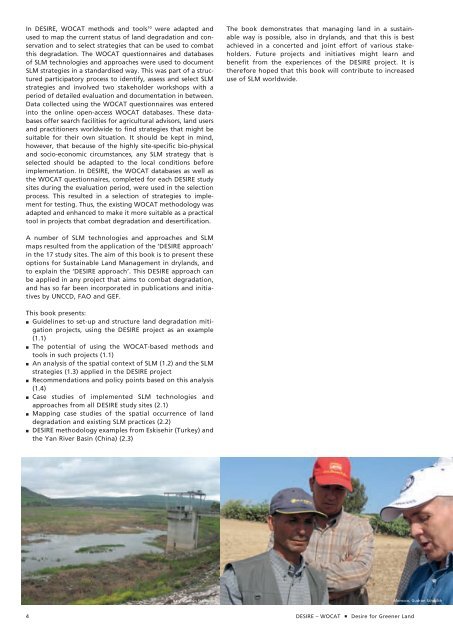Desire for Greener Land
Desire for Greener Land
Desire for Greener Land
You also want an ePaper? Increase the reach of your titles
YUMPU automatically turns print PDFs into web optimized ePapers that Google loves.
In DESIRE, WOCAT methods and tools 10 were adapted and<br />
used to map the current status of land degradation and conservation<br />
and to select strategies that can be used to combat<br />
this degradation. The WOCAT questionnaires and databases<br />
of SLM technologies and approaches were used to document<br />
SLM strategies in a standardised way. This was part of a structured<br />
participatory process to identify, assess and select SLM<br />
strategies and involved two stakeholder workshops with a<br />
period of detailed evaluation and documentation in between.<br />
Data collected using the WOCAT questionnaires was entered<br />
into the online open-access WOCAT databases. These databases<br />
offer search facilities <strong>for</strong> agricultural advisors, land users<br />
and practitioners worldwide to find strategies that might be<br />
suitable <strong>for</strong> their own situation. It should be kept in mind,<br />
however, that because of the highly site-specific bio-physical<br />
and socio-economic circumstances, any SLM strategy that is<br />
selected should be adapted to the local conditions be<strong>for</strong>e<br />
implementation. In DESIRE, the WOCAT databases as well as<br />
the WOCAT questionnaires, completed <strong>for</strong> each DESIRE study<br />
sites during the evaluation period, were used in the selection<br />
process. This resulted in a selection of strategies to implement<br />
<strong>for</strong> testing. Thus, the existing WOCAT methodology was<br />
adapted and enhanced to make it more suitable as a practical<br />
tool in projects that combat degradation and desertification.<br />
A number of SLM technologies and approaches and SLM<br />
maps resulted from the application of the ‘DESIRE approach’<br />
in the 17 study sites. The aim of this book is to present these<br />
options <strong>for</strong> Sustainable <strong>Land</strong> Management in drylands, and<br />
to explain the ‘DESIRE approach’. This DESIRE approach can<br />
be applied in any project that aims to combat degradation,<br />
and has so far been incorporated in publications and initiatives<br />
by UNCCD, FAO and GEF.<br />
This book presents:<br />
K Guidelines to set-up and structure land degradation mitigation<br />
projects, using the DESIRE project as an example<br />
(1.1)<br />
K The potential of using the WOCAT-based methods and<br />
tools in such projects (1.1)<br />
K An analysis of the spatial context of SLM (1.2) and the SLM<br />
strategies (1.3) applied in the DESIRE project<br />
K Recommendations and policy points based on this analysis<br />
(1.4)<br />
K Case studies of implemented SLM technologies and<br />
approaches from all DESIRE study sites (2.1)<br />
K Mapping case studies of the spatial occurrence of land<br />
degradation and existing SLM practices (2.2)<br />
K DESIRE methodology examples from Eskisehir (Turkey) and<br />
the Yan River Basin (China) (2.3)<br />
The book demonstrates that managing land in a sustainable<br />
way is possible, also in drylands, and that this is best<br />
achieved in a concerted and joint ef<strong>for</strong>t of various stakeholders.<br />
Future projects and initiatives might learn and<br />
benefit from the experiences of the DESIRE project. It is<br />
there<strong>for</strong>e hoped that this book will contribute to increased<br />
use of SLM worldwide.<br />
Italy, Gudrun Schwilch Morocco, Gudrun Schwilch<br />
4 DESIRE – WOCAT <strong>Desire</strong> <strong>for</strong> <strong>Greener</strong> <strong>Land</strong>









